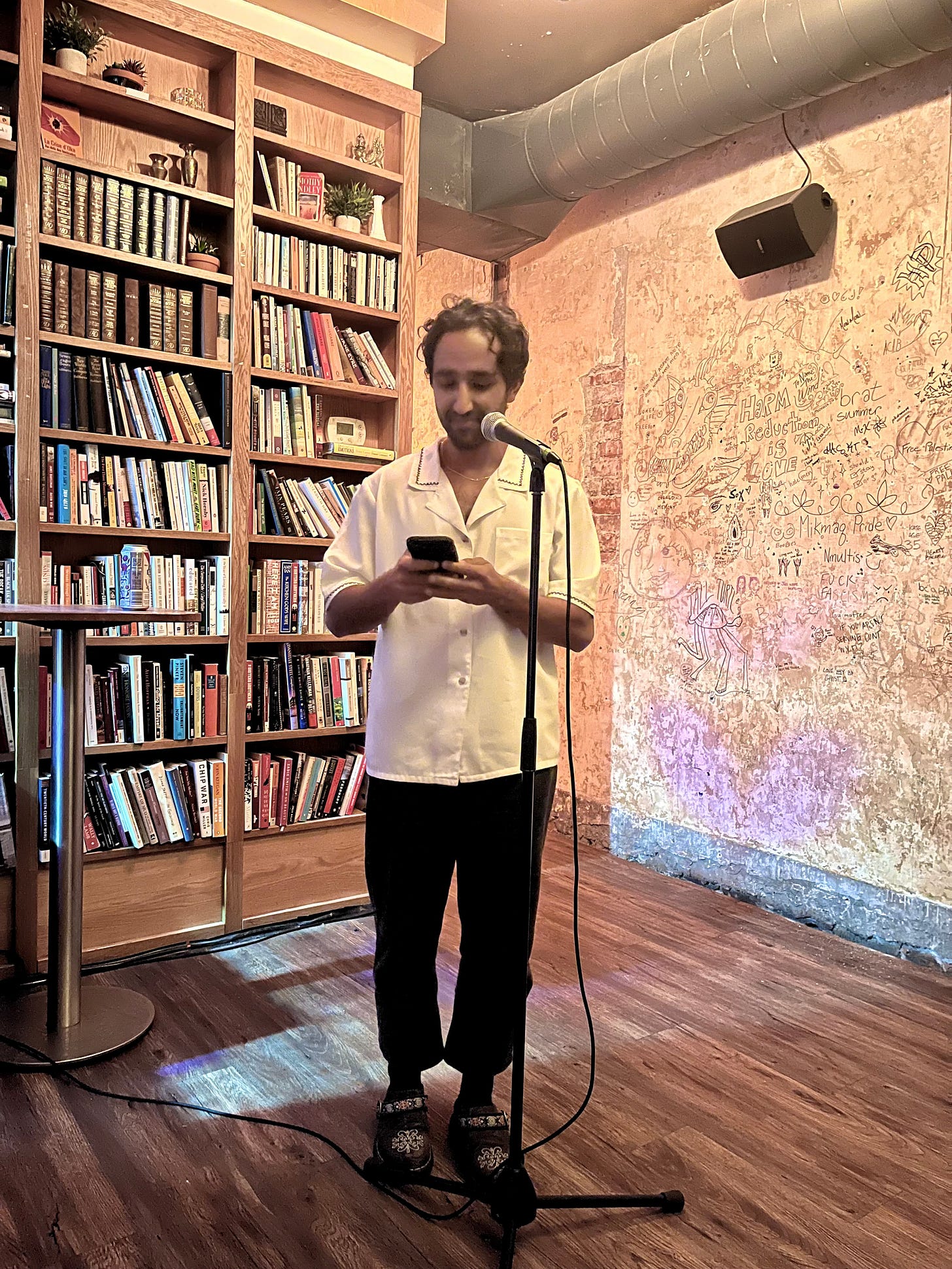I Am Not a Violent Man
But,
I’ll start this letter by affirming to you that I would never condone violence against another living being. In the rare instances where violence must be justified—as a necessary measure, or an unintended outcome, in the pursuit of one’s safety, for example—it is a net negative for all involved. That’s obvious. I didn’t even need to say that, but I did.
And now that I’ve made that clear, I can tell you that like anyone else, I succumb to the occasional act of violence. I am not a violent person; there is, in my opinion, no such thing. Violence lives outside of us, we succumb to it or we don’t, and the more we do, the more likely we are to succumb again. Considering the low-grade anger, bordering on violence, that surrounds my day-to-day—the man outside my window, for instance, who is laying on his horn and yelling English threats at the Uber Delivery guy in front of him, who is yelling Punjabi threats back, or the ear-splitting celebration laps of death machines at the Canadian Air Show each Labour Day weekend that not a single Toronto resident asked for—I am proud that the frequency with which I succumb to it is relatively low. But I do succumb. Let me explain how, and why.
I recently came home from a long trip. Having the unfortunate combination of compulsive cleanliness needs, and a housemate, means that the house I return to is always in worse condition than it was left. This is most evident when I go away in the summer months, when bugs are known to have sex and birth children in the comfort of our homes, protected from the cutthroat conditions outside. During this time, household bug volumes increase about twofold if I am home, and tenfold if I am not. The bugs are not disturbed by my housemate, it would seem, and I suppose that’s because he’s not particularly disturbed by them. From afar, during my travels, I imagine my house to be a peaceful, benevolent ecosystem. I was taught about this in Biology class—it’s called a commensalist relationship, in which one species, the bugs, benefits greatly, while the other species is unaffected. Sadly, I do not possess such magnanimity. Like most people, bugs instil in me a moderate revulsion, which I would attribute to their angularity, crunchiness, and ability to occupy spaces I cannot see. Often the revulsion is benign enough not to act upon. But there is one species that flourishes in the muggy Toronto summers, Drosophila melanogaster, commonly known as the fruit fly, that produces a rage within me I have not met anywhere else.
Now might be a good time to mention that I tried to be vegan for one year. And for almost six years, I have been vegetarian. Wait—scratch that. About a year ago, I started eating the occasional wild-caught fish. And I eat eggs, but they are the $10 free-range ethical ones, whatever that means. In the age of factory farming and food scarcity and climate change, I have not a single argument against the merits of veganism—ethically, it is the correct choice—but failing to live up to one’s ethical standards is part of being human, and I am a human.
So anyway, I plopped down my suitcase and explored the house I had been away from for a month. There were the typical minor offenses: the floors needed a deep-clean; my bedding more ruffled than I’d normally leave it, suggesting someone crashed without my knowledge; the Tupperware in the pantry separated from their lids—all things that could be quickly undone. I saved the kitchen for last, expecting the worst, and the worst was confirmed. Drosophila melanogaster, fucking everywhere. In the compost bin with their little maggot babies. Hovering around the garbage can. Zigzagging around anything that smelled like something, moving so sluggishly that they were practically begging to die. I didn’t unpack my bags, as I normally do first thing upon returning from a trip. I didn’t even change outfits from the plane. My priorities had been reshuffled.
Now, remember. I am not a violent person. Over the years, I have developed a system to humanely deal with Drosophila melanogaster. Step one is to create an ethical trap. The trap consists of a shallow bowl—a soy sauce saucer, for instance—in which I put a few tablespoons of apple cider vinegar, along with 3-5 soft blueberries, and a drop of soap. I then stretch saran wrap tightly over the bowl and poke 3-5 holes in the wrap with a push-pin. Once a fly enters the trap, for some reason it has no idea how to get out. They can’t climb upside-down on saran wrap, they don’t even try—perhaps because the transparency of it breaks their tiny brains, and they think it’s the sky. Most of them live and reproduce on the blueberries. Should any venture into the vinegar moat, the drop of soap breaks the surface tension, ensuring they drown immediately, thus humanely. Every twenty-four hours or so, I dump the contents outside so the mostly-surviving flies can carry on elsewhere. Then I rebuild the trap.
With the unprecedented fruit fly volumes after my recent trip, however, managing the traps was becoming a burden. Blueberries are expensive, as is apple cider vinegar. One night, I did not feel like going outside to empty a very full trap. Without thinking too much about it, I put it in the freezer. Thirty minutes later, I took it out. All the flies were dead. I told myself they were like frogs in a boiling pot; they never knew they were dying and then they died. This apologue was hardly applicable—the freezer attack was not gradual—and even if it was, it wouldn’t change the fact that I was boiling metaphorical frogs and freezing literal bugs alive. But that was my justification. Gradually, this indifference expanded to new realms. If a particularly juicy fruit fly was hovering in the open air, I would smack it between my palms as if on autopilot. CLAP. I would open my hands to a little dead thing, a tiny smear of blood, which would bring me a weird, carnal satisfaction, then I would wash it down the sink.
One time, I went on a fruit fly rampage. I’m not sure what set it off. I clapped one fly, then about thirty more. I kicked the garbage and compost bins repeatedly to release them, and continued my mass murder. I took down mothers, fathers, children, entire lineages, in a matter of minutes. It was fun. I was having a great time.
Another time I sat down on my toilet and on the floor, beside my thumb toe, a beetle was flipped upside-down, its limbs swiping uselessly at the air. It was trying with all its might to flip itself over. What a stupid creature, I thought, cruelly. I didn’t flip it over. I sat down on the toilet a few hours later and it was still there flailing, albeit a bit less. A day later it was still there, still upside-down, but dead.
I am not a violent person, I wrote in my journal, while reflecting on the 15-minute rampage. One is forced to do things for the safety of themselves, and by extension, their home. Flies are stupid, filthy, transient creatures. They make babies on your tomatoes and your bananas, proliferating quickly; leave them be and you’ll be outnumbered a million to one. This home—this set of bricks and appliances, protected by a piece of paper called a deed, which I entered into some years ago and will soon exit—takes precedence over an army of creatures whose brain cells have a thousandth the capacity of mine, who wake up and die in a matter of weeks. One must be careful about who they admit into their home. I wrote out this justification on paper, against the kitchen table of solid oak, feeling good about the sturdiness of my life, my surroundings, my ideas. My housemate entered the kitchen and opened the fridge. Two fruit flies were hovering around his head as he rummaged around. He didn’t notice them; he was indifferent, he was humming a song. One of the flies even landed on his hat, as if they were already acquainted, crawling towards his ear as if about to share a secret. I put down my pen and raised my clapping hands. The murderous rage struck me fast and hard, the attack straightforward and irresistible. This time, it had nothing to do with the fly.





